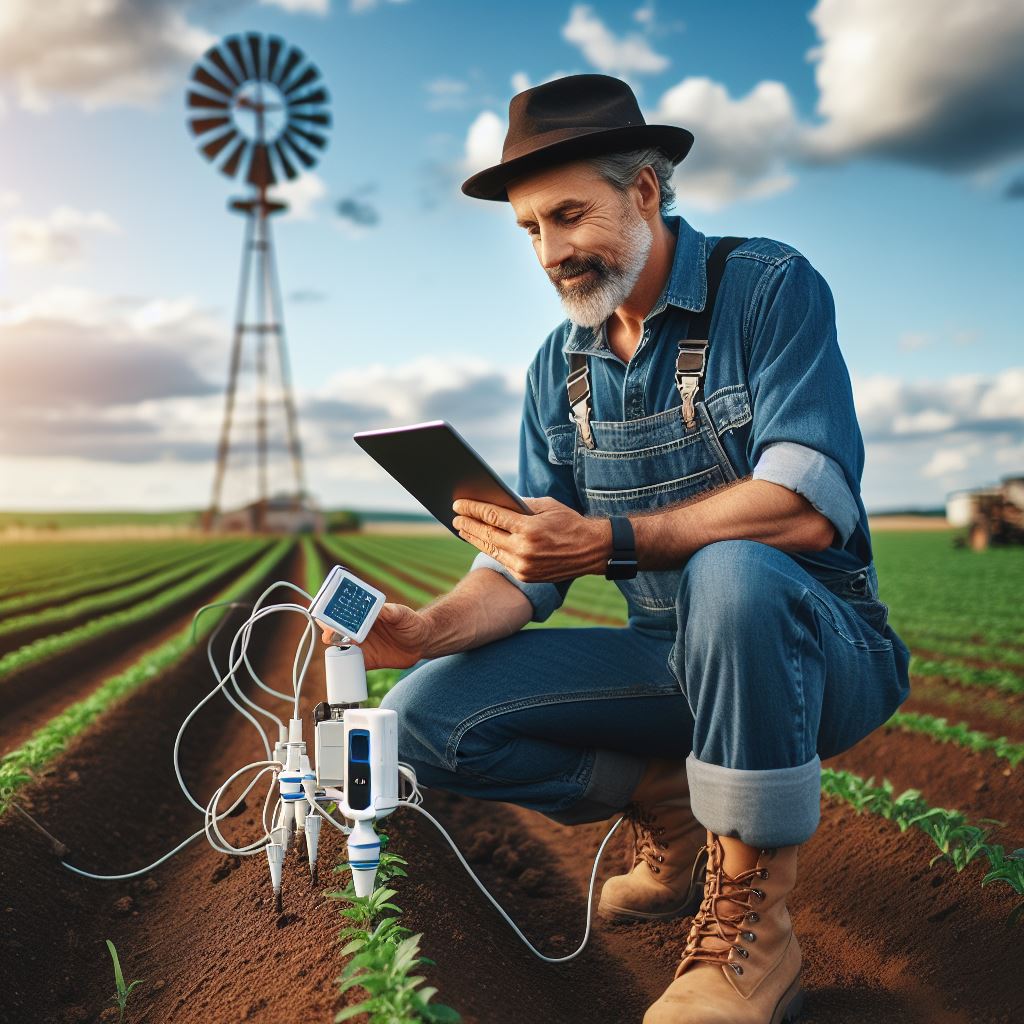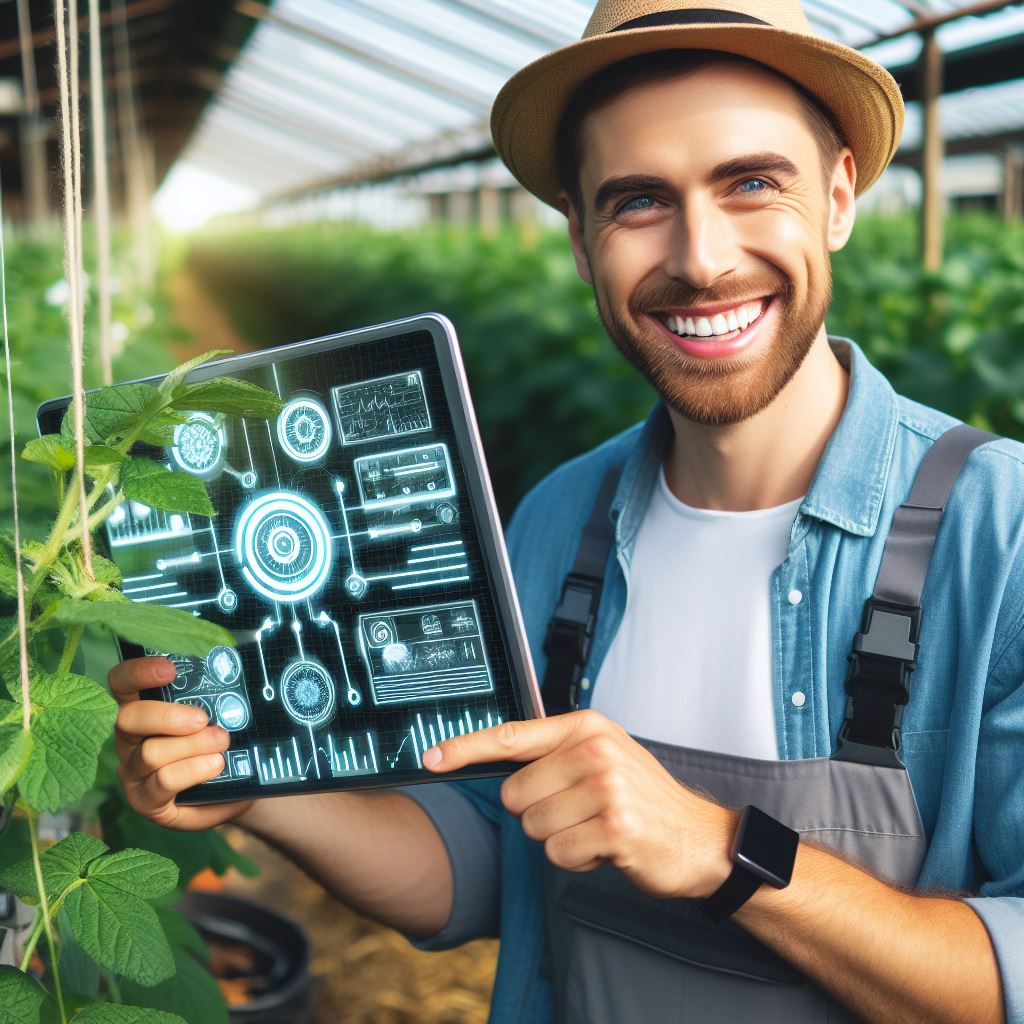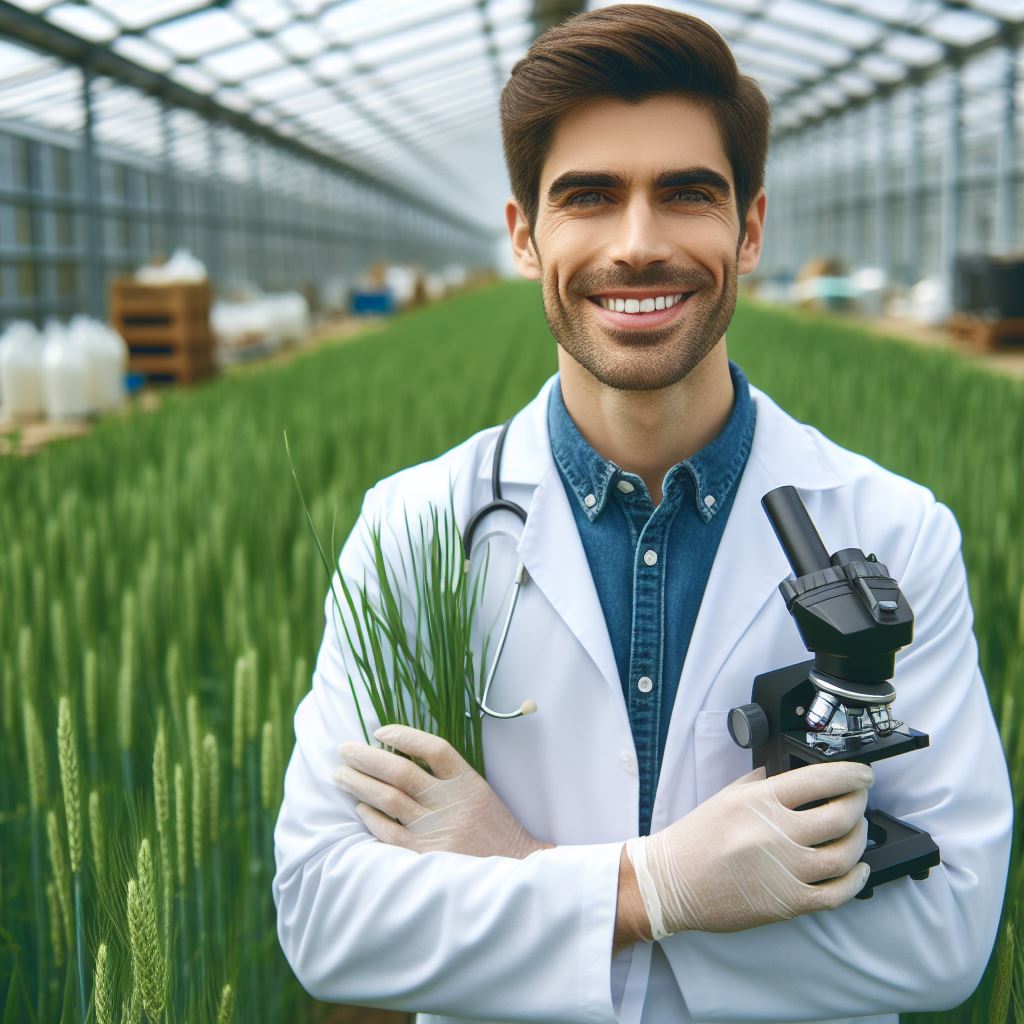Introduction
Crop monitoring plays a crucial role in agriculture by ensuring optimal plant growth and maximum yield.
With the advent of technology, modern farming practices have integrated advanced tools and techniques.
The use of technology in crop monitoring can bring several benefits, leading to better yields and increased profitability.
In the ever-evolving landscape of agriculture, maximizing crop yield while minimizing resource consumption stands as a paramount challenge.
The advent of technology has revolutionized farming practices, offering precision and efficiency like never before.
Among these technological marvels, crop monitoring emerges as a pivotal tool, facilitating informed decision-making and proactive interventions throughout the agricultural cycle.
By harnessing an array of sensors, drones, satellite imagery, and data analytics, farmers can gain real-time insights into crop health, soil conditions, and environmental factors.
This granular understanding empowers growers to optimize resource allocation, implement targeted interventions, and mitigate risks, ultimately enhancing productivity, sustainability, and profitability.
As we delve deeper into the realm of precision agriculture, the integration of cutting-edge crop monitoring technologies promises to redefine farming paradigms, ushering in an era of unprecedented yield optimization and resource efficiency.
Join us on a journey through the transformative potential of crop monitoring tech as we explore its multifaceted benefits and implications for the future of agriculture.
Importance of Crop Monitoring
Crop monitoring plays a crucial role in ensuring the success and profitability of agricultural practices.
Protecting crops from diseases, pests, and other threats
By monitoring crops regularly, farmers can identify and address potential issues such as diseases, pests, or nutrient deficiencies in a timely manner.
This helps prevent the spread of diseases and the infestation of pests, thereby protecting the overall yield.
Optimizing irrigation and fertilization for enhanced growth
Crop monitoring allows farmers to assess the moisture levels in the soil and determine the precise amount of irrigation required.
It also helps in monitoring nutrient levels and adjusting fertilization practices accordingly for optimal plant growth.
Transform Your Agribusiness
Unlock your farm's potential with expert advice tailored to your needs. Get actionable steps that drive real results.
Get StartedMaximizing yield and profitability for farmers
By closely monitoring crops, farmers can detect any abnormalities or signs of stress early on.
This enables them to take corrective measures promptly, resulting in increased crop yield and profitability.
Contributing to sustainable and efficient farming practices
Through crop monitoring, farmers can make informed decisions about resource allocation.
By optimizing the use of water, fertilizers, and pesticides, they can minimize waste, reduce environmental impact, and promote sustainable farming practices.
The Role of Technology in Crop Monitoring
Remote sensing
Using satellite imagery or drone technology, farmers can monitor large areas of crops efficiently and accurately.
Remote sensing provides valuable insights into crop health, growth patterns, and potential issues such as nutrient deficiency or pest infestation.
Sensor technology
Sensors placed in fields can monitor various parameters such as soil moisture, temperature, humidity, and nutrient levels.
This data helps farmers make data-driven decisions about irrigation, fertilization, and pest control.
Data analytics
Advanced data analytics tools allow farmers to analyze and interpret the data collected from crop monitoring.
This helps in identifying patterns, trends, and potential risks, enabling farmers to make informed decisions and take timely actions.
Mobile apps
There are numerous mobile applications available that allow farmers to monitor their crops remotely.
These apps provide real-time updates, weather forecasts, and pest alerts, enabling farmers to make proactive decisions from anywhere, anytime.
The Benefits of Crop Monitoring
Increased crop productivity
By identifying and addressing potential issues at the early stages, crop monitoring ensures healthier plants and higher crop yields.
Reduced production costs
Through optimized irrigation, fertilization, and pest control, farmers can minimize input costs, resulting in improved profitability.
Enhanced resource management
By monitoring crop health and environmental conditions, farmers can allocate resources more efficiently and reduce waste.
Improved sustainability
Crop monitoring facilitates the adoption of sustainable farming practices, leading to reduced environmental impact and long-term agricultural sustainability.
Crop monitoring is of utmost importance for protecting crops, optimizing growth conditions, and maximizing profitability.
With the help of technology, farmers can embrace efficient farming practices, make data-driven decisions, and contribute to sustainable agriculture.
Read: Irrigation Tech: Saving Water in Farming
Traditional Methods of Crop Monitoring
Crop monitoring has long been an essential practice in agriculture, allowing farmers to assess the health and progress of their crops.
Visual inspection by farmers
Traditionally, this task was carried out through visual inspection by farmers, who would walk their fields, visually identifying any signs of disease, pests, or nutrient deficiencies.
Although this method provided some level of understanding, it was often time-consuming and prone to human error.
Manual collection and analysis of data
Another traditional method of crop monitoring involved manual collection and analysis of data.
Farmers would record information about various parameters such as temperature, humidity, soil moisture, and pests, manually analyzing the data to make informed decisions about irrigation, fertilization, and crop protection.
Showcase Your Farming Business
Publish your professional farming services profile on our blog for a one-time fee of $200 and reach a dedicated audience of farmers and agribusiness owners.
Publish Your ProfileWhile this approach provided valuable insights, it required significant effort and expertise.
Challenges and limitations of these methods
However, traditional methods of crop monitoring have several challenges and limitations.
Visual inspection by farmers, while valuable, is subjective and relies heavily on the individual’s experience and observation skills.
This can lead to inconsistencies and inaccuracies in identifying issues, potentially leading to poor decision-making.
Manual collection and analysis of data also present challenges. Firstly, obtaining accurate and reliable data can be laborious, especially when dealing with large agricultural areas.
Secondly, the analysis of collected data can be time-consuming and complex.
Farmers need to have a deep understanding of agricultural science and be proficient in data interpretation to derive meaningful insights.
Moreover, traditional methods often lack real-time monitoring capabilities, making it difficult to identify issues promptly.
By the time problems are detected, the crops may already be significantly affected, resulting in reduced yields and economic loss for farmers.
Fortunately, advancements in technology have revolutionized crop monitoring, offering more accurate, efficient, and timely solutions.
One such technological innovation is the use of remote sensing, which enables the collection of data on a large scale without the need for physical presence in the fields.
Satellites, drones, and sensors can capture images and information about crops, soil conditions, and environmental factors.
Real-time monitoring systems have also emerged, providing farmers with instant access to crucial information about their crops.
With the help of IoT (Internet of Things) devices, farmers can remotely monitor soil moisture, temperature, and other parameters, enabling them to take immediate action when needed.
This proactive approach reduces the risk of crop damage and maximizes yields.
In fact, traditional methods of crop monitoring, including visual inspection and manual data collection, have limitations in terms of accuracy, efficiency, and real-time monitoring capabilities.
However, with technological advancements such as remote sensing, data analysis, and IoT devices, farmers now have access to better tools and techniques for monitoring their crops.
Embracing these technologies not only improves yields but also promotes sustainable and efficient agriculture practices.
Read: Climate-Smart Agriculture: Tools & Techniques
Role of Technology in Crop Monitoring
Introduction of remote sensing technologies
Remote sensing technologies have revolutionized crop monitoring by providing valuable insights.
These technologies use sensors to gather data about crop health, soil moisture, and weather conditions.
It allows farmers to monitor their crops without physically being present in the fields.
Utilizing drones and satellite imagery for data collection
Drones equipped with high-resolution cameras capture images of the fields from different angles.
These images provide detailed information about crop growth, nutrient deficiencies, and pest infestations.
Satellite imagery, with its wide coverage, helps monitor large agricultural areas and detect anomalies.
Advantages of data accuracy, speed, and scalability
- Remote sensing technologies enable accurate data collection, avoiding human errors and subjective interpretations.
- The timely acquisition of data allows farmers to identify problems early and take necessary actions.
- The scalability of these technologies makes it possible to monitor crops on a large scale.
Integration of Artificial Intelligence (AI) for data analysis and decision-making
Artificial Intelligence algorithms can analyze large volumes of data and extract meaningful insights.
AI can identify patterns, predict crop yields, and recommend optimal planting and harvesting timings.
This integration enhances decision-making processes, leading to increased productivity and better yield.
Read: Vertical Farming: Tech Meets Tradition
Types of Tech for Crop Monitoring
Crop monitoring is an essential practice in agriculture as it allows farmers to obtain valuable information about their crops.
This information helps them make informed decisions to maximize their yields and minimize losses. In recent years, technology has revolutionized the way crop monitoring is done.
There are several types of tech that are being used for crop monitoring:
Weather stations and sensors
In this context, weather plays a crucial role in crop growth and development. Weather stations equipped with sensors collect real-time data on temperature, humidity, rainfall, and wind speed.
This data helps farmers understand the weather patterns and adjust irrigation and fertilization practices accordingly.
Soil moisture sensors
In this context, soil moisture is another vital factor in crop growth. Soil moisture sensors measure the amount of moisture present in the soil.
This information guides farmers in determining the right time to irrigate and avoid both under and over-watering.
Proper irrigation management leads to healthier plants and higher yields.
Crop health monitoring systems
Crop health monitoring systems use remote sensing techniques to detect plant stress, diseases, and nutrient deficiencies.
Advanced satellite imagery and drones equipped with multispectral cameras capture data that is analyzed to identify crop health issues.
Showcase Your Farming Business
Publish your professional farming services profile on our blog for a one-time fee of $200 and reach a dedicated audience of farmers and agribusiness owners.
Publish Your ProfileEarly detection allows farmers to take corrective actions promptly and prevent further damage.
Yield mapping and GPS technology
Yield mapping involves collecting data on crop yield variations across a field. GPS technology is used to precisely track the location of the harvested crops.
This information helps farmers identify the areas with different yield potentials and make site-specific management decisions.
It also enables them to assess the effectiveness of specific practices and adjust them accordingly.
Crop management software
Crop management software integrates various data sources and provides comprehensive insights into crop performance.
It allows farmers to analyze data from weather stations, sensors, and other sources, and make data-driven decisions.
This software also helps in tracking and managing inputs, such as fertilizers and pesticides, optimizing resource allocation, and improving overall farm productivity.
These technological advancements in crop monitoring have several benefits for farmers.
Firstly, they help optimize resource use, leading to cost reduction.
By precisely monitoring weather and soil conditions, farmers can avoid unnecessary irrigation, fertilization, and pesticide application.
This not only saves money but also reduces the environmental impact.
Secondly, technology-driven crop monitoring helps in early detection and prevention of crop diseases and pest infestations.
Farmers can take immediate action and prevent the spread of diseases, thus reducing crop losses. This proactive approach ensures healthier crops and higher yields.
Thirdly, the use of tech for crop monitoring enables farmers to comply with regulatory requirements and certifications.
Accurate record-keeping and data analysis can help farmers provide proof of sustainable practices, which is increasingly demanded in the market.
This can open up new marketing opportunities and premium prices for their produce.
Overall, crop monitoring technology empowers farmers with data-driven insights that enhance decision-making and improve crop productivity.
By leveraging weather stations, soil moisture sensors, crop health monitoring systems, yield mapping, and crop management software, farmers can optimize resources, prevent crop losses, and stay ahead of challenges.
It is vital for farmers to embrace these technologies and stay updated with the latest developments to ensure better yields and a sustainable future for agriculture.
Read: CRISPR Crop Edits: Future of Farming Tech

Benefits of Tech for Better Yield
Technology has revolutionized the agricultural industry, leading to better crop yield and increased profitability for farmers.
The benefits of using technology for better yield are numerous and have a significant impact on crop monitoring and management.
Early detection of crop diseases and pests
One of the key advantages of using technology in crop monitoring is the early detection of crop diseases and pests.
With advanced sensors and imaging techniques, farmers can identify diseases and pests at their initial stage, allowing them to take prompt action to control and prevent their spread.
This timely intervention helps in minimizing the damage caused to crops, resulting in higher yields.
Optimum irrigation and fertilization management
Another benefit of technology in crop monitoring is the ability to optimize irrigation and fertilization management.
By using sensors and data analytics, farmers can monitor soil moisture levels and nutrient requirements in real-time.
This information enables them to supply precise amounts of water and fertilizers to the crops, ensuring efficient resource utilization and minimizing wastage.
This not only improves crop yield but also reduces the environmental impact of excessive irrigation and fertilizer application.
Improved resource utilization and reduced wastage
Technology plays a vital role in improving resource utilization and reducing wastage in crop production.
By employing precision farming techniques such as GPS-guided equipment and automated machinery, farmers can optimize the use of inputs such as seeds, pesticides, and fuel.
This reduces unnecessary wastage, cuts down on production costs, and maximizes the overall yield.
The efficient use of resources also has a positive impact on the environment by minimizing pollution and conserving natural resources.
Data-driven decision-making for effective crop management
The availability of data through technology enables farmers to make informed decisions for effective crop management.
By collecting and analyzing data on weather conditions, soil quality, and crop performance, farmers can make precise decisions regarding planting schedules, pest control measures, and harvesting techniques.
This data-driven approach ensures that farmers can optimize their practices and achieve better yields while minimizing the risks associated with uncertainties in crop production.
Increased profitability and sustainability for farmers
Ultimately, the adoption of technology for better crop yield leads to increased profitability and sustainability for farmers.
By leveraging technology to improve crop management practices and reduce losses, farmers can achieve higher yields and better quality produce.
This not only boosts their income but also enhances the sustainability of their farming operations.
Increased profitability allows farmers to reinvest in their farms, adopt more sustainable practices, and contribute to the overall growth and development of the agricultural sector.
Showcase Your Farming Business
Publish your professional farming services profile on our blog for a one-time fee of $200 and reach a dedicated audience of farmers and agribusiness owners.
Publish Your ProfileIn brief, the benefits of using technology for better crop yield are immense. From early detection of crop diseases and pests to data-driven decision-making, technology enhances crop monitoring and management.
It enables farmers to optimize irrigation and fertilization, improve resource utilization, and make informed decisions.
Ultimately, technology promotes increased profitability and sustainability, making it a crucial tool for modern farming practices.
Challenges and Limitations of Tech in Crop Monitoring
As technology continues to advance, its incorporation in the agricultural sector has become increasingly important.
Crop monitoring, in particular, benefits greatly from technological solutions that can improve yield and efficiency.
However, along with the countless advantages, there are several challenges and limitations that need to be addressed for successful implementation.
Initial costs and investments
One of the primary challenges of incorporating technology in crop monitoring is the initial costs and investments required.
High-tech equipment and software can be expensive, making it inaccessible for smaller farms with limited financial resources.
Additionally, ongoing maintenance expenses can also add to the financial burden.
Data integration and compatibility issues
Another significant obstacle in crop monitoring technology is the integration and compatibility of different systems and software.
With a wide range of devices and platforms available, ensuring seamless data transfer and synchronization can be a complex task.
This can lead to inefficiencies and data loss, hampering the effectiveness of the technology.
Technological literacy among farmers
Despite the progress made in the agricultural sector, there is still a significant digital divide between technologically literate farmers and those who struggle with basic tech skills.
Lack of knowledge and training can hinder the adoption and effective use of crop monitoring technology.
Educating farmers about the benefits and usability of these solutions is crucial for successful implementation.
Privacy and data security concerns
With the increasing use of technology comes the concern over privacy and data security.
Crop monitoring involves the collection and storage of sensitive data, such as farm layouts, crop types, and yield data.
Farmers need assurance that their information is protected from unauthorized access and misuse.
In a nutshell, while technology has the potential to greatly enhance crop monitoring and improve yield, there are several challenges and limitations that need to be addressed.
The initial costs and investments, data integration and compatibility issues, technological literacy among farmers, and privacy and data security concerns are significant factors that must be taken into account.
By finding solutions for these obstacles, the agricultural sector can fully harness the benefits of technology for better yield and sustainable farming practices.
Conclusion
In this blog post we recap the importance of crop monitoring for better yield:
- Crop monitoring plays a crucial role in maximizing agricultural production and ensuring food security.
- It helps farmers identify and address potential issues that can affect crop health and productivity.
- By monitoring crops regularly, farmers can make informed decisions about irrigation, fertilization, and pest management.
- Technology has revolutionized crop monitoring, making it more efficient and accurate.
- Drones, satellites, and sensors provide real-time data on crop conditions, allowing for timely interventions.
Technology enables farmers to monitor larger areas and identify problem areas quickly.
It helps optimize resource allocation, leading to higher efficiency and reduced costs.
Remote sensing technologies help monitor soil moisture levels, temperature, and nutrient content.
Data analytics and AI algorithms provide insights to optimize crop management practices for maximum yield.
We also highlighted some of the benefits and address the challenges:
- Crop monitoring reduces yield loss due to disease, pest infestations, and adverse weather conditions.
- It improves the quality of crops and increases the profitability of farming operations.
- However, implementing technology in agriculture requires initial investment and technical know-how.
- Interpreting and utilizing the vast amount of data collected can also be challenging for farmers.
Adopting technology in crop monitoring can lead to better yields and increased profitability.
Farmers should stay updated with the latest advancements and seek assistance from experts.
Government and private entities should provide support in terms of training and access to technology.
By embracing technology, farmers can overcome challenges and ensure sustainable agriculture for the future.




